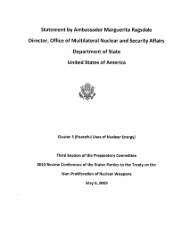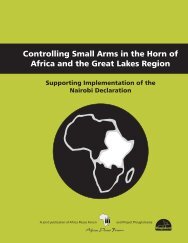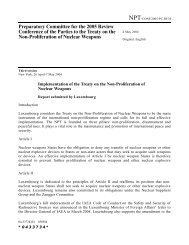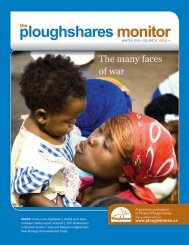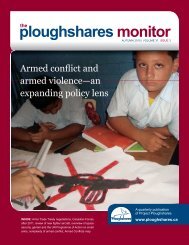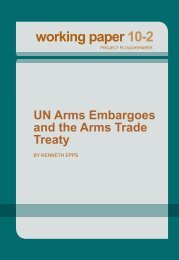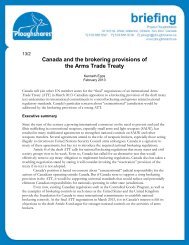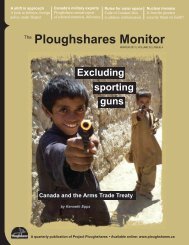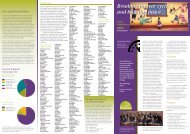Addressing Armed Violence in East Africa.pdf - Project Ploughshares
Addressing Armed Violence in East Africa.pdf - Project Ploughshares
Addressing Armed Violence in East Africa.pdf - Project Ploughshares
Create successful ePaper yourself
Turn your PDF publications into a flip-book with our unique Google optimized e-Paper software.
<strong>Address<strong>in</strong>g</strong> <strong>Armed</strong> <strong>Violence</strong> <strong>in</strong> <strong>East</strong> <strong>Africa</strong>3. KenyaInstitutionsThe armed violence lens <strong>in</strong>corporates <strong>in</strong>to its analyticalframework the formal and <strong>in</strong>formal <strong>in</strong>stitutions that governcommunity life <strong>in</strong> a given area and have an impact on levelsof violence. These could be local government <strong>in</strong>stitutions andthe police or traditional community leadership such as elders,chiefs or laibons. Disarmament exercises organised by thegovernment are one part of Kenya’s <strong>in</strong>stitutional response togun violence <strong>in</strong> the North Rift Valley.Disarmament exercisesGovernment-directed disarmament exercises <strong>in</strong> this partof Kenya were recalled <strong>in</strong> <strong>in</strong>terviews with vary<strong>in</strong>g degreesof praise and criticism. Some were highly sceptical of theseefforts: “The government is do<strong>in</strong>g little. In voluntary amnestiesa family with five guns may surrender one gun with no realimpact on the overall availability of guns.” To be effective,disarmament of neighbour<strong>in</strong>g communities must be done <strong>in</strong>parallel; cross-border disarmament must be coord<strong>in</strong>ated withother countries to remedy problems of porous borders.Sometimes <strong>in</strong>terviewees contrasted the lax Kenyan governmentapproach with stricter gun control <strong>in</strong> Uganda.The Uganda government used the military to controlborders and to disarm civilians <strong>in</strong> a more aggressivemanner but Kenya did not match these efforts.Comprehensive disarmament is required. Unlike Uganda,the Kenyan government also does not follow up with<strong>in</strong>cidents.With resentment several Turkana who were <strong>in</strong>terviewedrecalled Kenyan government-<strong>in</strong>itiated gun disarmamentprocesses that were, <strong>in</strong> their view, one-sided: “The governmenttried twice to disarm civilians but it was only done among theTurkana, leav<strong>in</strong>g them open to imbalanced attacks from thePokot.” “In 2005 there was disarmament. The community triedvery hard to surrender illegal firearms. When their enemiesrealised this, they attacked them from Sudan and from theKaramojong <strong>in</strong> Uganda. The Turkana are surrounded byenemies.” Asymmetric disarmament appears to have resulted<strong>in</strong> bitterness and a quick rearm<strong>in</strong>g of Turkana warriors: “Theyhoped the government would play its role to reduce guns <strong>in</strong>the other communities but this did not take place. So gunownership went back up.”In the Marakwet area the government reportedly conducteddisarmament exercises <strong>in</strong> the 1950s, 1960s, 1979, 1984 and2005. Apparently, even the colonial government undertookdisarmament exercises. Only the 2005 exercise, which was verypeaceful, was successful, accord<strong>in</strong>g to one person <strong>in</strong>terviewed.WVK reportedly participated, as did other NGOs and theLutheran church. More than 2,000 guns were collected, mostlyfrom crim<strong>in</strong>als who were identified by the community. Another<strong>in</strong>terviewee answered:There have been cases of gun runners arrested or dissuadedfrom practice. In one case where a man was arrested heagreed to give up his bus<strong>in</strong>ess and was given money by anNGO to start a bus<strong>in</strong>ess. Now he is a pastor.The <strong>in</strong>gredients for peace betweenPokot and MarakwetThe armed violence unleashed by the <strong>in</strong>troduction of automaticweapons <strong>in</strong> pastoralist areas has been mitigated <strong>in</strong> some placesbut the overall picture is grim. By contrast, <strong>in</strong>terviews with theMarakwet provided a very hopeful story of peace be<strong>in</strong>g madewith their opponents, the Pokot. The many factors that madethis peace possible and last<strong>in</strong>g constitute an example than canpossibly be replicated elsewhere. One of the most compell<strong>in</strong>gstories of this field research was the assembly by the Marakwetof the <strong>in</strong>gredients for peace. These <strong>in</strong>gredients are discussed <strong>in</strong>the follow<strong>in</strong>g paragraphs.In Marakwet territory, security was said to improve after theelection of the new Kenyan government <strong>in</strong> 2002. In the calm,communities were able to come together to deal with theirdifferences. “S<strong>in</strong>ce this peace, farm<strong>in</strong>g cont<strong>in</strong>ues, childrenhave gone back to schools, the pre-school has re-opened. Tocompensate for livestock taken by the Pokot, the Marakwethave bought more livestock and settled and now have milk.”Economic and livelihood diversity also played a role. Inaddition to cattle and goat graz<strong>in</strong>g, the Marakwet have takenup such agricultural practices as grow<strong>in</strong>g vegetables and othercrops. The Pokot have come to rely on the Marakwet for food.“The Pokot and Marakwet share together <strong>in</strong> the markets; theyare graz<strong>in</strong>g together <strong>in</strong> the fields. Some Pokot come and farmwith the Marakwet. If they are farm<strong>in</strong>g, they don’t have worriesabout gunshots. From 2005 it has been like this.”24



